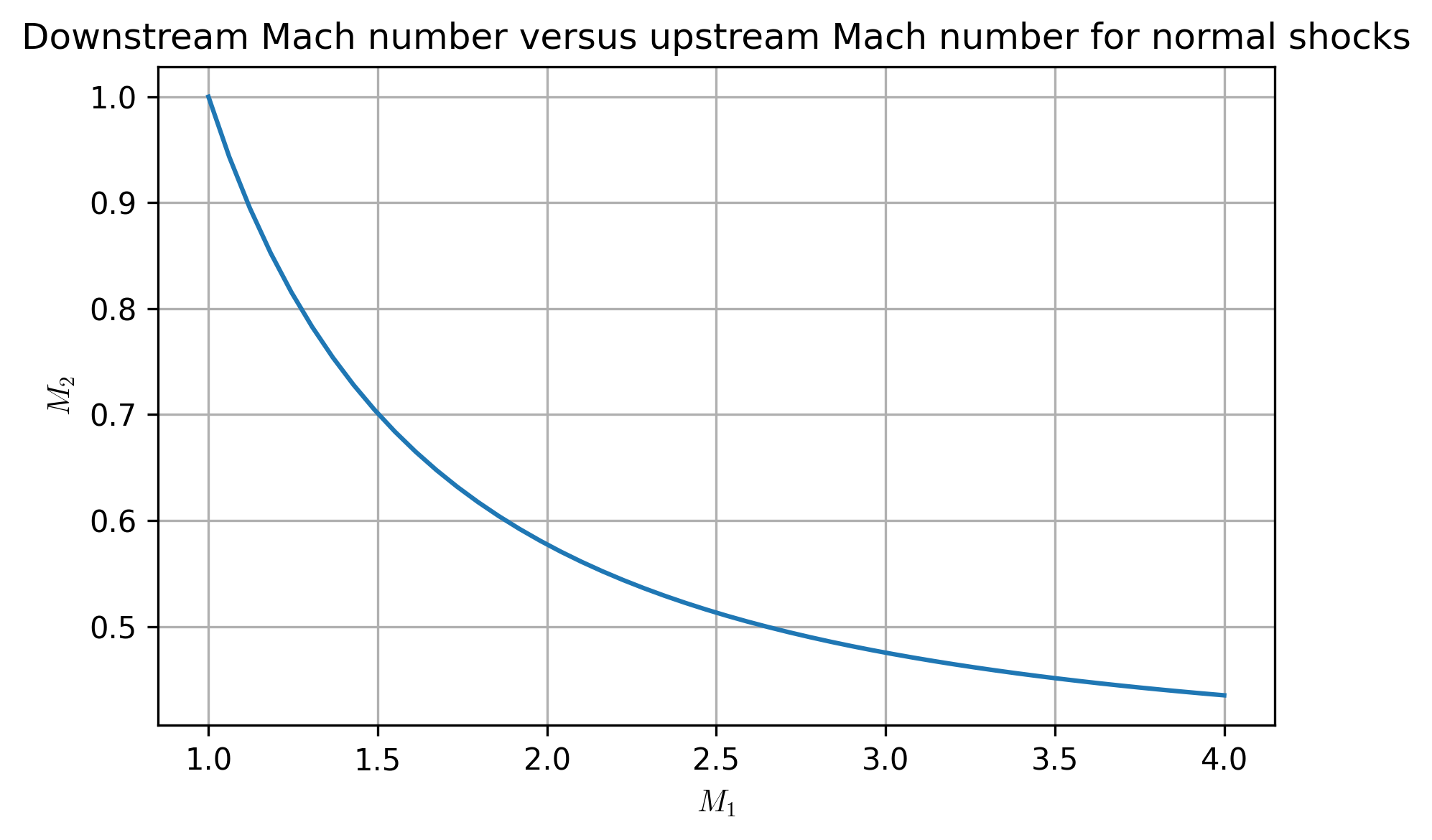Normal shock waves¶
%matplotlib inline
from matplotlib import pyplot as plt
import numpy as np
# Pint gives us some helpful unit conversion
from pint import UnitRegistry
ureg = UnitRegistry()
Q_ = ureg.Quantity # We will use this to construct quantities (value + unit)
# these lines are only for helping improve the display
import matplotlib_inline.backend_inline
matplotlib_inline.backend_inline.set_matplotlib_formats('pdf', 'png')
plt.rcParams['figure.dpi']= 300
plt.rcParams['savefig.dpi'] = 300
plt.rcParams['mathtext.fontset'] = 'cm'
Shock waves are finite pressure disturbances that correspond to a large change in properties over a short distance, on the order of a few free molecular paths of the gas. In contrast, sound waves are infinitesimal disturbances.
We can analyze the flow through a shock wave with a control volume, applying our existing conservation equations.

Fig. 1 Control volume around a shock.¶
Figure 1 shows a control volume around a shock wave, in a duct with varying area. The thickness of the control volume is very small, on the order of the thickness of the shock itself (so \(dx \sim 10^{-6}\) m). We will make the following assumptions about the flow:
steady, one-dimensional flow
adiabatic flow process: \(\delta q = 0\), and so \(ds_e = 0\)
no shaft work across the control volume: \(\delta w_s = 0\)
no potential change: \(dz = 0\)
constant area around the shock: \(A_1 = A_2\)
We can apply conservation of mass to this control volume:
conservation of energy:
and momentum:
For an arbitrary fluid, we have three equations: (23), (24), and (25). In a typical problem, we know the fluid and conditions before the shock, and want to find the conditions after the shock. Thus, our known variables are \(\rho_1\), \(p_1\), \(h_1\), and \(V_1\), while our unknown variables are \(\rho_2\), \(p_2\), \(h_2\), and \(V_2\). We need a fourth equation to close this system of equation: a property relation for the fluid, otherwise known as an equation of state.
Perfect gases¶
For ideal/perfect gases, we have the ideal gas equation of state, and can assume constant values for \(c_p\), \(c_v\), and \(\gamma\). We also have a convenient relationship for the speed of sound:
Incorporating these into Equation (23) we can obtain
With our stagnation relationship for temperature, \( T_t = T \left( 1 + (\gamma-1)M^2 / 2 \right)^2 \), Equation (24) becomes
which applies both around a normal shock and also at any point in a general flow with no work or heat transfer. Lastly, incorporating our relationships for perfect gases into Equation (25) we obtain
Now, we have three equations and three unknowns: \(M_2\), \(p_2\), and \(T_2\). 😎
However, it is a bit of a pain to solve this complicated system of equations every time. Fortunately, we can combine all three together and eliminate pressure and temperature completely!
which can actually be solved to find \(M_2 = f(\gamma, M_1)\). A trivial solution to this equation is that \(M_1 = M_2\), where there is no shock. (What does this mean? Just that the governing equations we set up apply just fine for a flow where there is no shock—good news!)
For nontrivial solutions, with some painful algebra we can rearrange this equation into a recognizable form:
where \(A, B, C = f(\gamma, M_1)\). This looks like a quadratic equation! The only physically viable solution to this equation is
gamma = 1.4
mach1 = np.linspace(1.0, 4.0, num=50, endpoint=True)
mach2 = np.sqrt((mach1**2 + 2/(gamma-1))/(2*gamma*mach1**2/(gamma-1) - 1))
plt.plot(mach1, mach2)
plt.xlabel(r'$M_1$')
plt.ylabel(r'$M_2$')
plt.title('Downstream Mach number versus upstream Mach number for normal shocks')
plt.grid(True)
plt.tight_layout()
plt.show()

A typical problem flow is that we have \(\gamma\) and \(M_1\), use these to determine \(M_2\), and then use Equations (27) and (28) to obtain \(T_2\) and \(p_2\). More convenient versions of these equations are
Note
Since \(M_1 > 1\), \(M_2 < 1\) always for a normal shock.
